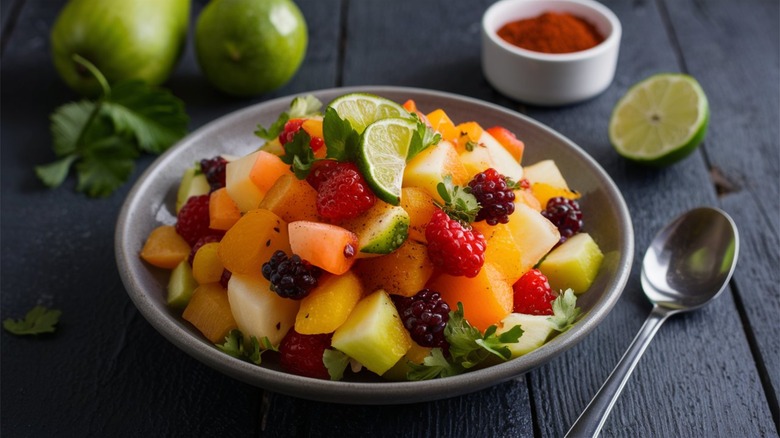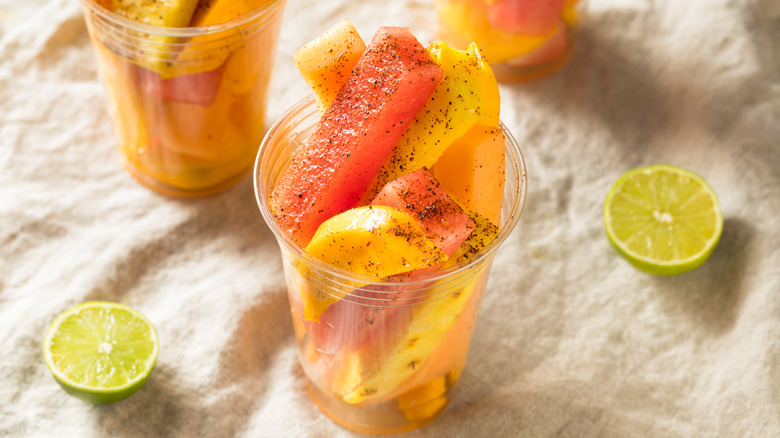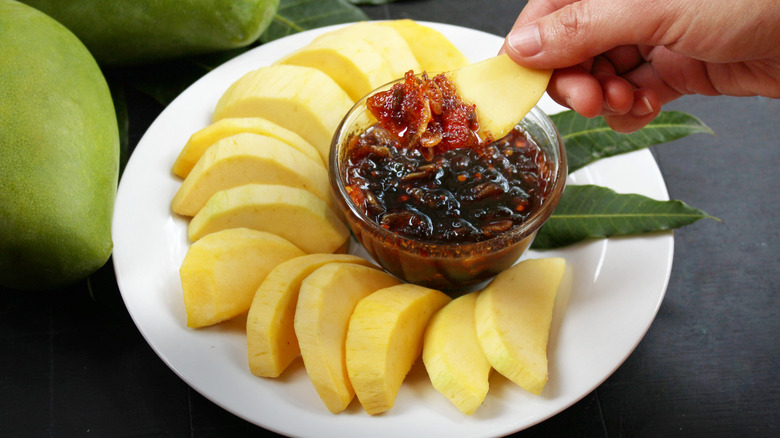Liven Up A Fruit Salad With A Sprinkle Of Tajín
Biting into a piece of fruit is good, digging into a mix of perfectly ripe chunks of fruit is great, but fruit salad with a zippy seasoning is perhaps best of all. If you grew up in a Mexican household, freshly-cut fruit with a generous shower of Tajín is likely a go-to snack, but if you have not had the chance to taste it, get ready for the best fruit salads of your life.
Tajín is a seasoning mix that contains chili powder, salt, and dried lime, and though it is not the only brand that makes such a product, the name Tajín is now used generically, as is similar to brands such as Crock-Pot and Kleenex. When paired with fruit, it creates a refreshing, bright, sweet, and savory flavor.
To try it, just cut the fruit into cubes, add a squeeze of fresh lime, orange, or lemon juice for vibrancy, and a touch of sugar, honey, or agave syrup to emphasize the sweetness of any produce that is not perfectly ripe. You can even splash tequila into fruit salad for a bright, boozy burst of flavor. Then, season the fruit with Tajín to taste. If you are particularly sensitive to spice or saltiness, start with a little and work your way up. Keep in mind that the salt will draw out moisture from the fruits, so it is best to sprinkle it on just before serving so that the fruit salad does not get too liquidy.
The best fruits to pair with Tajin
Fruits such as mangoes, papayas, pineapples, honeydew, cantaloupes, kiwis, watermelons, apples, strawberries, and more are all delicious with Tajín's salty, spicy, and tart seasoning. You can even sprinkle it on spears of cucumber, jicama, or carrots for a more savory snack. The flavor of Tajín is very versatile, but it is best served with a cut fruit so the powder has a surface to cling on to. It will fall right off ones with skins or membranes, like grapes, blueberries, or mandarin orange segments.
Classic Mexican fruit cups ("vasos de fruta" in Spanish) take the spicy and fruity pairing to the max with all kinds of creative mixes. They combine tropical fruits and melons alongside cucumbers and jicama and are commonly sold at the beach, on the street, and in outdoor markets. It is typical for all the produce to be cut into large spears, served in a tall cup, and dressed with fresh lime juice, salt, Tajín, hot sauce, and a drizzle of chamoy for a sweet-tart hit. You can replicate this experience at home by preparing cups with a variety of fruits and setting out all the aforementioned condiments, so folks can make their own perfectly spicy fruit cup. Both serving and eating is way more convenient than pre-assembled salad in a bowl.
Spicy seasonings for fruit from around the globe
Pairing fruit with chilies and salt is a go-to flavor combination in many different regions of the world, and you can and should take inspiration the next time you want to turn regular fruit salad into something special. In Thailand, fresh fruits are commonly served with a variety of Tajín-like dips, with perhaps the most simple and common being prik glua — it combines salt, sugar, and fresh red chilies or chili flakes. Kapi wan, which has roasted shrimp paste in the mix as well, leans more savory.
Others like umami-packed nam pla wan and the similar Laotian version called jeow mak muang are saucier — they combine ingredients like chilies, sugar, fish sauce, dried shrimp, and shallots. Tart green mango is a classic pairing, but either is also a particularly great choice if you break into a watermelon that happens to fall flat taste-wise — fish sauce can totally elevate mediocre watermelon.
Indian fruit chaats are also salty and spicy. They are commonly dressed in dried red chili powder, ground cumin, and chaat masala. Chaat is a broad term for snacks — they can include a number of fresh and cooked vegetables, tangy chutneys, yogurt, crunchy things, and more — and the chaat masala is essential. The blends vary, but they almost always have amchur (tart dried mango powder) and bold kala namak (black salt), which makes for a totally unique fruit salad with deep umami flavors.



